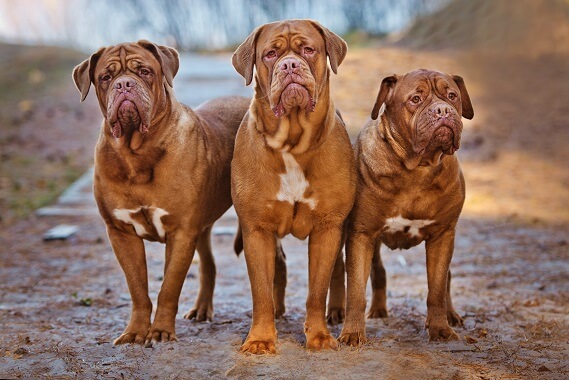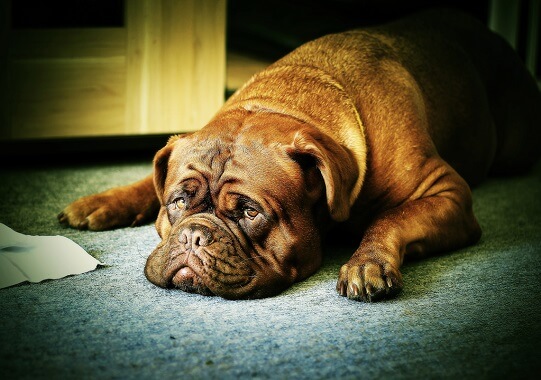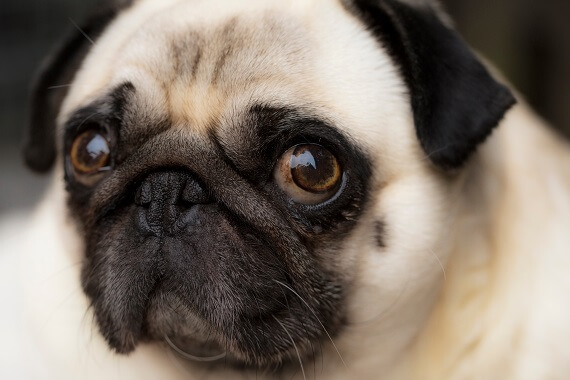
The Dogue de Bordeaux, otherwise known as the Bordeaux Mastiff or French Mastiff, is a large mastiff breed that originated in France around 600 years ago. It is one of the oldest French dog breeds. The Dogue de Bordeaux is a giant, well-balanced and muscular dog that is known for its massive head, sweet disposition, and powerful body. They have a devoted, courageous, and even-tempered temperament, which makes them ideal pets. Their massive head has a Bulldog-like undershot jaw and oval-shaped eyes that are set wide apart. Proportionally, they have the largest head in the canine kingdom! These dogs have a stocky body that is close to the ground and is covered in soft, short fur that is fawn in color. They have prominent wrinkles on their face and thick, loose-fitting skin on the rest of their body. They are known for lots of drooling! Dogue de Bordeaux can be sweet and docile but they also have a stubborn and arrogant side so they require a firm handler who provides consistent training and socializing to prevent any aggression problems. These dogs are loyal and territorial and as such make excellent guard dogs. They are also capable of several sports and activities, including tracking, search and rescue, and therapy work. As with many large breeds, the Dogue de Bordeaux has a shorter lifespan than many small dogs, with an average lifespan of 5 – 8 years. They can have several health problems so will require regular vet check-ups. These dogs require moderate exercise and like to play. They must get exercise every day so that they don’t carry excess weight which can put a strain on their body. These dogs originated in France’s Bordeaux region 600 or more years ago, which is where they take their name from. They historically guarded the homes of France’s elite but after the French revolution, they were put to work pulling carts and guarding flocks. A uniform breed of these dogs was not established until around 1920. They first gained interest from the American public with the release of Tom Hank’s 1989 film, Turner and Hooch, and have been gaining in popularity ever since. The Dogue de Bordeaux is a loveable character that is large in size, loyal, and can be very affectionate. These gentle giants originated in France sometime in the 14th century but have only recently gained popularity as a household pet in other countries. They were first recognized as a breed by the American Kennel Club in 2008. These dogs have been bred to be large powerhouses that were once used as guard dogs and this has resulted in some traits and characteristics that have an impact on their biology. Let’s take a closer look! Drool is one of those issues that is associated with several dog breeds and in excessive droolers, this can result in a puddle on the floor. Drool is just excessive saliva that has accumulated in the dog’s mouth, which the dog can not retain. A dog’s salivary glands are constantly producing saliva, and it increases when the dogs smell or taste something enticing. A disagreeable taste, such as medicine, can also result in excess saliva so that the dogs can get rid of the taste they don’t like. Saliva can also be produced when dogs become too hot and it enables them to cool down. In certain breeds, such as the Dogue de Bordeaux, the structure of the head and the lips can not retain the drool that these dogs produce. The saliva builds up in the loose skin folds around the mouth where it either drips to the floor or is flung around when the dog shakes its head. Owners of these dogs need to be prepared and keep a drool cloth handy! While this is all completely natural, excessive drooling in breeds that don’t drool a lot can be a warning sign of a more serious problem. This can include heat stroke, nose and throat infections, kidney disease, liver disease, and rabies. One of the most recognizable characteristics of the Dogue de Bordeaux is its loose skin that creates wrinkles and folds across its body. Unfortunately, this trait can lead to some health conditions. One of these is caused by the loose skin around its eyes and is known as ectropion. In this condition, the skin at the base of the eyelids hangs down, exposing tissues that are meant to remain hidden and protected. These conditions make the eyes very prone to infection, damage, and contamination and require regular vet checks to ensure that everything is as it should be. Other breeds that are likely to suffer from this condition include bloodhounds, St Bernards, and other mastiff breeds.
Kingdom
Animalia
Phylum
Chordata
Class
Mammalia
Order
Carnivora
Family
Canidae
Genus
Canis
Species
Canis lupus
Subspecies
Canis lupus familiaris
Height
23 – 26 in (58 – 66 cm) at the shoulder
Weight
99 – 110 lbs (approximately 44.5 – 50 kg)
Lifespan
5 – 8 years
Social Structure
Domesticated, working group
Status
Least concern
Natural Habitat
Domesticated
Average Litter Size
8
Main food item
Dog food
Potential predators
Few predators
The Basics

Fun Facts about the Dogue de Bordeaux!

Excessive droolers

Ectropion
